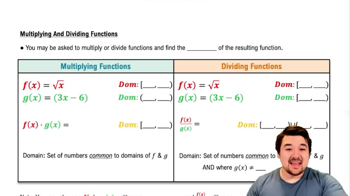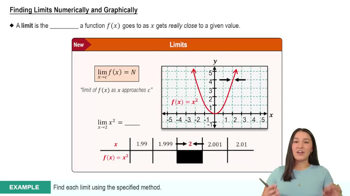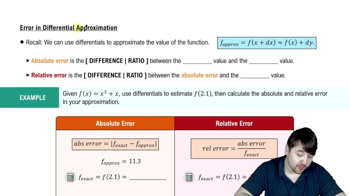Let ƒ(x) = 3x - x³ . Show that the equation ƒ(𝓍) = -4 has a solution in the interval [2,3] and use Newton’s method to find it.
Table of contents
- 0. Functions7h 54m
- Introduction to Functions16m
- Piecewise Functions10m
- Properties of Functions9m
- Common Functions1h 8m
- Transformations5m
- Combining Functions27m
- Exponent rules32m
- Exponential Functions28m
- Logarithmic Functions24m
- Properties of Logarithms36m
- Exponential & Logarithmic Equations35m
- Introduction to Trigonometric Functions38m
- Graphs of Trigonometric Functions44m
- Trigonometric Identities47m
- Inverse Trigonometric Functions48m
- 1. Limits and Continuity2h 2m
- 2. Intro to Derivatives1h 33m
- 3. Techniques of Differentiation3h 18m
- 4. Applications of Derivatives2h 38m
- 5. Graphical Applications of Derivatives6h 2m
- 6. Derivatives of Inverse, Exponential, & Logarithmic Functions2h 37m
- 7. Antiderivatives & Indefinite Integrals1h 26m
- 8. Definite Integrals4h 44m
- 9. Graphical Applications of Integrals2h 27m
- 10. Physics Applications of Integrals 3h 16m
- 11. Integrals of Inverse, Exponential, & Logarithmic Functions2h 31m
- 12. Techniques of Integration7h 41m
- 13. Intro to Differential Equations2h 55m
- 14. Sequences & Series5h 36m
- 15. Power Series2h 19m
- 16. Parametric Equations & Polar Coordinates7h 58m
4. Applications of Derivatives
Differentials
Problem 29b
Textbook Question
[Technology Exercise] Roots
Let ƒ(𝓍) = 𝓍³ ―𝓍― 1.
b. Solve the equation ƒ(𝓍) = 0 graphically with an error of magnitude at most 10⁻⁸ .
 Verified step by step guidance
Verified step by step guidance1
Start by understanding the function ƒ(𝓍) = 𝓍³ - 𝓍 - 1. This is a cubic function, and we are tasked with finding its roots, i.e., the values of 𝓍 for which ƒ(𝓍) = 0.
Graph the function ƒ(𝓍) using a graphing tool or software. This will help visualize where the function crosses the x-axis, indicating the roots. Look for points where the curve intersects the x-axis.
Use a numerical method such as the Newton-Raphson method to refine the root estimates obtained from the graph. This method involves iterating using the formula: 𝓍ₙ₊₁ = 𝓍ₙ - ƒ(𝓍ₙ) / ƒ'(𝓍ₙ), where ƒ'(𝓍) is the derivative of ƒ(𝓍).
Calculate the derivative of the function ƒ(𝓍) = 𝓍³ - 𝓍 - 1, which is ƒ'(𝓍) = 3𝓍² - 1. Use this derivative in the Newton-Raphson formula to iteratively find a more accurate root.
Continue iterating using the Newton-Raphson method until the difference between successive approximations is less than 10⁻⁸, ensuring the error magnitude is within the specified tolerance.
 Verified video answer for a similar problem:
Verified video answer for a similar problem:This video solution was recommended by our tutors as helpful for the problem above
Video duration:
5mPlay a video:
Was this helpful?
Key Concepts
Here are the essential concepts you must grasp in order to answer the question correctly.
Roots of a Function
The roots of a function are the values of the variable for which the function equals zero. In this case, we are looking for the values of 𝓍 that satisfy the equation ƒ(𝓍) = 0. Finding roots is essential in understanding the behavior of functions and their intersections with the x-axis.
Recommended video:

Multiplying & Dividing Functions
Graphical Method for Finding Roots
The graphical method involves plotting the function on a coordinate system and visually identifying where the curve intersects the x-axis. This method provides an intuitive understanding of the function's behavior and can be used to approximate roots, especially when combined with numerical techniques to achieve a specified error margin.
Recommended video:

Finding Limits Numerically and Graphically
Error Tolerance in Numerical Methods
Error tolerance refers to the acceptable range of error when approximating solutions, in this case, a maximum of 10⁻⁸. In numerical methods, achieving a solution within this tolerance ensures that the root found is sufficiently accurate for practical purposes, which is crucial when using graphical or iterative methods to solve equations.
Recommended video:

Determining Error and Relative Error

 5:53m
5:53mWatch next
Master Finding Differentials with a bite sized video explanation from Patrick
Start learningRelated Videos
Related Practice
Textbook Question
